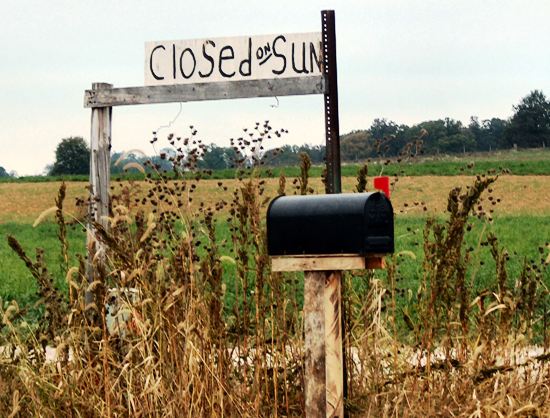The Amish Puppy Mill Controversy
You may have heard that the Amish have been accused of treating puppies poorly in what have been termed ‘puppy mills’.
 There have been some highly-publicized cases of animals kept in deplorable conditions. One occurred just recently in Wisconsin. PA supposedly has the rep of ‘puppy mill capital of the East’, due in large part to some Amish breeders in Lancaster County. An article (no longer available) out today reports on a controversial puppy auction in Ohio.
There have been some highly-publicized cases of animals kept in deplorable conditions. One occurred just recently in Wisconsin. PA supposedly has the rep of ‘puppy mill capital of the East’, due in large part to some Amish breeders in Lancaster County. An article (no longer available) out today reports on a controversial puppy auction in Ohio.
Dog breeding can be fairly lucrative. One Amishman in Indiana told me that he planned to sell pups of one particular breed for $500 a pop. He intended to undercut the prevailing rate of around $600. Not too bad.
The News-Herald Ohio auction story mentions ‘designer dogs’–specially bred mixes–going for up to $5,000.
At the same time, a good amount of work is involved. Pugs for example can be particularly hard to breed. Birthing is tough on the mother and they are finicky eaters when young.
Breeders typically keep animals in cages as they grow and await buyers.
I doubt it’s much fun to live in a cage, but I’ve met a healthy handful of Amish pup breeders (though not in PA or Wisconsin), and never noticed any conditions of cruelty like described in these articles.
I’m not a vet, but there was no matted hair nor signs of emaciation. The pups seemed lively.
Cruelty to animals is deplorable. But it also seems that the amount of noise the public will make in your defense is directly proportional to how ‘cute and lovable’ your species is.
Baby seals and koala bears, and puppies, usually make out pretty well in that regard. Rats, pigeons, and other less-cuddly creatures, not really.
Visit the ASPCA site.





“Baby seals and koala bears, and puppies, usually make out pretty well in that regard. Rats, pigeons, and other less-cuddly creatures, not really.”
You sound like a rat to me. So I guess you’d better be careful.
Just a general observation.
Rats have their defenders too!
http://www.phillyratrescue.com
Please help stop the breeding of dogs-there are other ways to make money.Shelters have to kill millions of animals to make room for ever more-there are too many dogs in this world who need homes.Be reasonable.God does not want the suffering of his creatures
I totally agree
If the evidence I have seen coming from Amish puppy mills is true, then this is a deplorable “witness” to their Christian faith, and I say that as someone who is a committed, believing Christian, who knows how to read Scripture where Proverbs says, “A righteous man regards the life of his beast, but the tender mercies of the wicked are cruel” (Proverbs 12:10)
uhm sir, no one has Rat Mill farms tourchrering and selling sick rats to the community. hello!
Actually....
Pet rat rescues are often overwhelmed with the many sick and unsocialized rats being sold by pet stores that people then turn over to rescues when they can’t handle them.
http://www.phillyratrescue.com
http://www.ratchickratrescue.com
http://www.mainelyratrescue.org
In New York State there were some Amish who put to sleep lots of dogs and puppies (I don’t know how many), that they were raising because they had some diease. It was against the law to put them down the way they did. A friend of mine knows an Amish Bishop, also in New York State, who among being a farmer also raises dogs. The Amish Bishop is upset because he feels some Amish are giving all Amish dog raisers a bad name. He only has four dogs he breeds. He does not have a puppy mill. He goes very careful and above and beyond all the care in laws and regulations and now he can’t sell his puppies because people think all Amish dog raisers are like the one that is in trouble. It has got him and some really honest Amish dog raisers upset.
Marilyn
in New York
I worked at an animal rescue that would buy dogs and puppies from Amish puppy mills. The only reason that we would buy them is because if we didn’t then they would either be shot or drown. Seeing how I’ve actually been to the puppy mills and rescued the dogs/puppies, I know what the conditions are like. The mills themselves are disgusting, no ventilation, dirty water, barely any food, no medical attention, etc. The long haired dogs always need shaved because they are a giant mat, and every dog/puppy needs to be medicated for numerous intestinal parasites. The Amish even tried to perform home c-sections, of course we would get the dying mothers who were riddled with infection. Have you ever heard of cage legs? Maybe you should go research that seeing how a lot of the puppy mill dogs have that. Also, go research the psychological effects that the mills have on the dogs. 99.9% of the puppy mill dogs/puppies that we rescued were absolutely terrified of people, they didn’t know that petting was good or that treats were good.
Amish puppy mills
This is such a sad subject and I am so sorry some Amish got involved and were not in any way kind, caring or responsible in breeding.
Like Elizabeth, I too volunteer in rescue – truly, if you saw the horror of some Amish puppy mills you would be shocked, disgusted and saddened.
We have also adopted seniors from Amish puppymill rescues when they were shut down. My little 4.8 lb 18 yr old Maltese was rescued at 13 yrs, gave birth to 3 puppies a few days later.
These rescues were beyond matted. My sweet little one is quite typical in that she had no teeth (knocked out by the breeder), a bark that sounds like a duck due to a rod being shoved down her throat to quiet the barking. She had 3 very large mammary tumors removed after rescue.
This darling has been with us 5 yrs now – she takes valium everyday, otherwise she would live in terror…but she is happy and safe…though she has moments when she will stand very still, hang her head and stare at the floor…if we did not pick her up she would do this for a long time.
Again, it was shocking & heartbreaking to find and see for myself, that some Amish farmers are among the very worst owners of puppymills.
Please do not purchase anything, even food or a toy, from a pet shop that sells puppies. No matter what they may tell you, these puppies come from Mills. No reputable breeder would ever allow their pups to be sold in a shop.
Many blessings,
Christine
VERY MOVING
It was very moving to read your descriptions of your Maltese girl. Long after I’d left this page and gone on to other stuff, the images stayed in my head.
Are you on Facebook?
Amish puppy mill
I have a Boston who came from an Amish puppy mill in Wisconsin when he was 6 months old. Hes now 10. He still has fears common to mill dogs. He’s fearful of going through doorways, and will sit outside staring at the door like he’s seeing a ghost. He is. Puppy mills will slam a dogs head in the door to deter them from running away. He’s afraid of hoses and will keep his distance if it’s just lying in the yard. He cowers in the corner if I’m using the hose to water the garden. Puppy mills don’t bother taking dogs out of the kennels to hose them out. He’s been with me 8 months, and just recently I’ve found he’s fearful of brooms, fly swatters and leaf rakes. I can only guess that they were used to hit him. People need to stop buying from mills and pet stores. Its the only way to stop this abuse.
Puppy Mill
I was hoping this was just fiction, like in this book. https://www.amazon.com/Puppy-Mill-Murder-Amish-Tale/dp/1543033318/ref=sr_1_1?ie=UTF8&qid=1521827507&sr=8-1&keywords=puppy+mill+murder
Puppy Mills
I had not heard of this issue. What I have seen in recent years were ongoing instances of our federal government filth harassing and persecuting the Amish people’s right to farm and sell their products. Puppy mills are a whole different issue. It would seem that many still do not either know or care that thousands of unwanted pets are abandoned, mistreated and / or euthanized because there are simply not enough homes for all of them.
A second issue that I am seeing is the use of draft and other horses until they are so worn out and / or damaged that they are of no further use to some Amish folks. These horses are just dumped at auctions and then bought by kill-buyers who truck them for long distances for slaughter. This is obscene and cruel beyond belief. I don’t think that all Amish do these things but those who do, are casting a very poor light on the rest of the Amish folks.